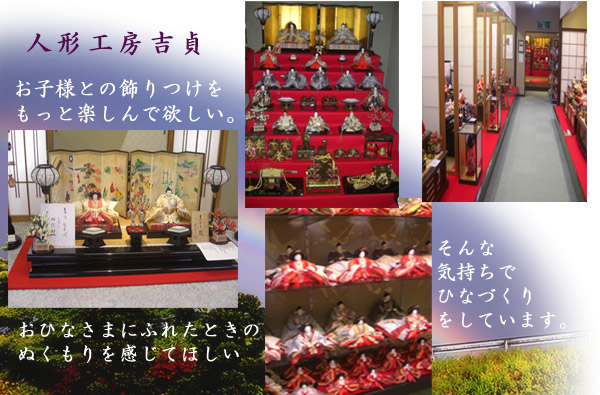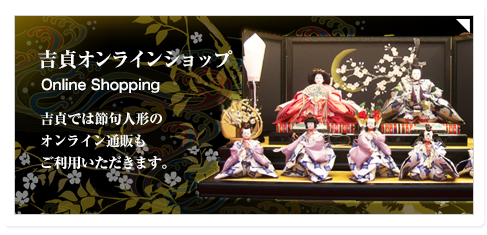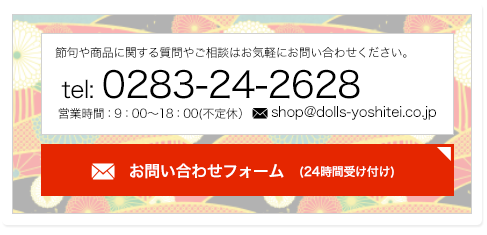ひな祭りの起源は、大昔で、源氏物語の須磨の巻などに上巳の節供についての描写があります。
そこには、等身大の藁で作った人像を船で流したお祓いの行事であることが、垣間見えます。
その後も高貴な方たちの由帷子を使ってのお祓いの話や、室町時代の撫で物使いの話など、八百万の神の国らしく、神様に、悪い事がないようのお願いするための贖物を用意する文化であったと考えられます。
同時に室町に入ると貴族の中でそれらひとがたを愛玩する文化(姫様たちのままごと)が始まりました。
このことによって、お雛さまは、段々立派なものとなり、毎年更新することが難しくなったと考えられます。
そこで、その無病息災への思いを叶えるため、屋敷に神様に来ていただこう、そのための工夫が、お家の中の聖域(結界)が赤い毛氈であり、床の間であったと考えられています。
江戸時代に入って身分制度が固まる中、大名や大商人といった人たちによって、お雛文化は、発展しました。
そういった人たちが、自分の娘や孫娘に自分より豊かに幸せになって欲しいと願う時、予祝の考え方が入ってきたように思います。
予祝とは、幸せは、急に来ないもの、お祝いを重ね待っていることでやっと来てくれるものだという考え方で、将来の幸せな結婚を祈念して、ひな飾りに赤ちゃんの身代わり(分身)であるお雛様が幸せな結婚をした状態で雛飾りにするようになったと考えられる。
だから、身分制度が固まった江戸時代では、自分より地位の高い人たちとの婚礼(究極は、将軍様か天皇陛下))となるのでしょうか、そういった三国一の花婿(立派な衣装を着せたお内裏様なる人形)を金屏風の前に(自分の娘、孫娘にお内裏様に釣合いのとれた衣装を着せたお雛様なる人形)分身と対で飾ることで将来の幸せも合わせてお願いするようになったと考えられる。
丁度皆さんが神社へ言って神頼みをする時、色々と一度にお願いする(日本人的思考)ように、せっかくお家に神様に来ていただいているのだから、色々な人形や道具に思いを託して、ひな飾りを作り、赤ちゃんの無事成長、将来の幸せなど考えられることを、お家に来ていただいた神様にお供え物をしお願いするお家の中だけの小さなお祭りであり、毎年その子のためにやってあげる身祝いとして続けていただいております。
Beginning of a Girl’s Festival, there is description about Jiyomi’s seasonal festival in Maki in Suma of the Tale of Genji in ancient times.
The thing which is an event of the purification ceremony let run by ship can have a glimpse of the person image made with life-sized straw there.
I can think it was the Bunka when shokumono of the purpose I’ll request which is so that there were also no things bad for God appropriate for a country of a god of eight million such as the fact that you’re conducting traditional ceremonies to expel evil spirits and an account of stroking thing usage in Muromachi era using people’s high way mail after that is prepared.
When I enter Muromachi at the same time, it’s in the aristocrat, that and others, the Bunka when a dummy is petted (a princess, playing house) has started.
Mr. chick can think it became difficult it was something wonderful and that it’s being renewed every year gradually by this thing.
So to grant expectation to the perfect state of health, it’s thought a sacred precinct in the house (boundary fence) was a red rug, and that the device for it which will have God come to the residence was an alcove.
While a class system hardens from the Edo Period, chick culture is developed by people such as daimyos and wealthy merchants.
When hoping that such people want their daughter and granddaughter to be more abundantly than oneself happily, I think a way of thinking of arakajimeshuku came in.
arakajimeshuku is something to which I don’t come suddenly and the way of thinking to which you come finally by piling up and waiting a celebration happily, and I can think Mr. chick who is baby’s scapegoat (alter ego) in a chick ornament prayed for future happy marriage, and started to make it a chick ornament in the state which got married happily.
So will a class system be a bridal with people more high-ranking than oneself (for an ultimate, generals or His Majesty the Emperor)) in the Edo Period which hardened, I can think such bridegroom unparalleled in the world (the doll Mr. Imperial Palace who put a wonderful costume on will be) to have come to request together with future happiness by displaying the (doll Mr. chick who put the costume the daughter and granddaughter could balance for Mr. Imperial Palace on will be in front of the gilt folding screen by branching and a pair.
When everyone says to a shrine and prays to God for help exactly, variously, together, please, (Japanese thought), like, because I have God come to the house hard, I make an offering to the God who entrusted expectation to various dolls and tools, made a chick ornament and had come baby’s safe growth and the case that future happiness is considered in a house, please, it’s small only in house, you’re deifying and you continue it as the personal celebration I’ll do for the child every year.






